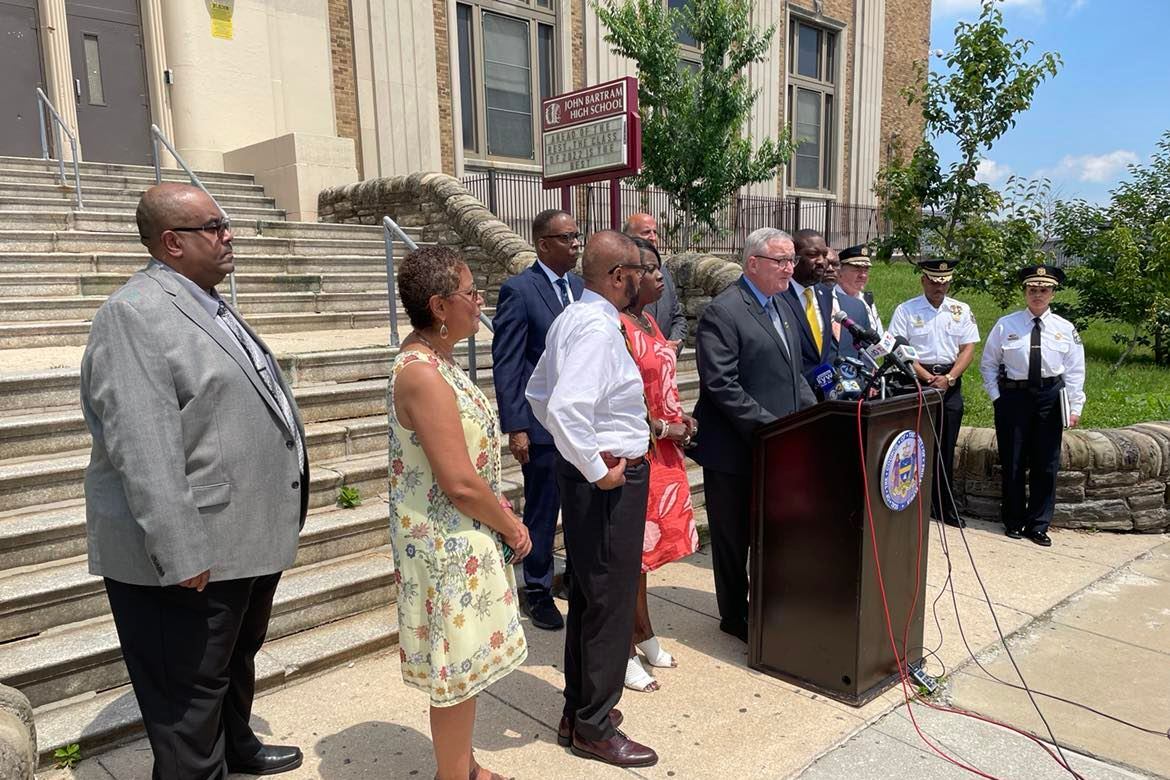Christopher Braxton, a senior at John Bartram High School in Southwest Philadelphia, was gunned down near the school’s campus shortly after dismissal in January.
An 18-year-old student at Frankford High School was injured in a drive-by shooting that happened just blocks away from the school, also in January.
And Juan Carlos Robles-Corona Jr., an eighth grader at Tanner Duckrey School, died by gunfire near the school in North Philadelphia in April.
City, police, and school officials say those and other shootings near district campuses are the reason behind plans unveiled Monday to install 100 security cameras near schools impacted the most by gun violence.
Council President Darrell Clarke is expected to introduce legislation at a Tuesday council meeting that will include $1.8 million to install the cameras in 15 designated areas near 19 schools where students have been impacted by gun violence as they travel to and from school.
“As you hear people talk about Uvalde, we have Bartram, we have Dobbins,” Clarke said, referring to the school shooting in Texas last month. “We need to pay attention to the schools in the city of Philadelphia.”
As of June 9, 94 residents under the age of 18 have been shot in 2022 — an 8% increase from this time last year, according to city statistics.
In a few instances, a designated area covered by the cameras would include more than one individual school.
More schools could be added to the list of those covered by the new security cameras as the program is implemented, according to district officials.
Officials made it clear that the security cameras are an added security measure and will not replace the highly criticized metal detectors installed in some elementary and middle schools last month.
Mayor Jim Kenney, who faced heavy criticism for not declaring a state of emergency in response to last year’s historic gun homicide numbers, said support for the new cameras show that city leaders are united and recognize the situation’s urgency.
“I want to assure our residents and visitors that public safety remains our top priority. We will not stop working until we resolve the disturbing rise in violence in our city. This is an example of everybody being on the same page. And we’ve been accused of not being on the same page,” Kenney said.
At least one school official expressed regret that officials didn’t make the proposal to add security cameras sooner. Bartram Principal Brian Johnson said had the proposed security cameras been up and running months ago, officials by now probably would have identified who shot Braxton, the student at his school.
Kenney said the city’s police department has been working with principals to establish safe zones and corridors around schools, with the support and collaboration from communities.
Last month, the district announced periodic weapon screenings at middle schools. Every middle school would be subject to those screenings at least once before the end of the school year.
Officials at Monday’s announcement made a point of highlighting other ongoing efforts to safeguard students.
Police Commissioner Danielle Outlaw was also on hand to promote the city’s Safe Corridors initiative, which has been around for years, in which community volunteers work to ensure students are getting to school and back home safely. Safe Corridors is spearheaded by the district and local businesses are also involved.
Volunteers often work in teams, sharing information and reporting any suspicious or unusual activities with school administrators.
“A child or parent should never ever have to worry about being deliberately harmed, in or on the way to and from our schools, period,” Outlaw said.
This school year also marked the start of the Philadelphia School Safe Zones, a joint effort led by the police department and the district. Law enforcement and school officials have identified 38 schools spread across 25 safety zones that would benefit from an increased police presence. These zones primarily focus on middle and high schools that were selected and using the latest crime data available.
“Officers assigned to these zones are on the lookout for suspicious activity, and mainly to create safe spaces for our students as they head to and from school,” Outlaw said.
The 19 schools that would be covered by the cameras include:
- Edison and Clemente Schools
- Mastbaum High School
- Bartram High School
- South Philadelphia High School
- Fels High School
- Lincoln High School, Austin Meehan Middle School, and Northeast Community Propel Academy
- Dobbins High School
- Ben Franklin High School
- Duckrey High School
- High School of the Future
- Frankford High School
- Kensington Creative and Performing Arts High School
- Northeast and Wilson Schools
- Roxborough High School
- Harding Middle School
Bureau Chief Johann Calhoun covers K-12 schools and early childhood education in Philadelphia. He oversees Chalkbeat Philadelphia’s education coverage. Contact Johann at jcalhoun@chalkbeat.org.







